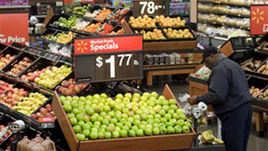 New rules hailed as the biggest improvements in U.S. food safety since the 1930s took a step forward Friday. Regulators say the proposals may prevent more than one million cases of foodborne illness each year.
New rules hailed as the biggest improvements in U.S. food safety since the 1930s took a step forward Friday. Regulators say the proposals may prevent more than one million cases of foodborne illness each year.
They come two years to the day since President Barack Obama signed the Food Safety Modernization Act. They are the first step in implementing that law, which puts the Food and Drug Administration [FDA] in charge of preventing foodborne disease outbreaks. Experts say that’s a change from the reactive role it has played in the past.
Passage of the law followed a string of high-profile nationwide disease outbreaks linked to bagged spinach, peanut butter and other foods, in which hundreds of people became ill.
“They occurred because of problems that would have been addressed by these kinds of approaches. So I think we’re very optimistic that we’ll begin to see real change,” said FDA Commissioner Margaret Hamburg.
Preventive measures
The new approaches FDA has proposed call for food manufacturers to show that they have identified where contamination is most likely to happen, and taken steps to prevent it. The proposed rules also set safety standards for raising and harvesting fruits and vegetables.
The Congressional Budget Office estimates that implementing all of the law’s provisions will cost the government $1.4 billion dollars. Food makers support the law, though the Grocery Manufacturers of America, a major industry trade group, declines to estimate what it will cost producers.
But with about one in six Americans getting sick from contaminated food each year, FDA’s deputy commissioner Michael Taylor said it will be worthwhile.
“Even if you just look at estimated reductions in illness. But if you also take into account avoiding disruption of the food supply and the loss of confidence in those commodities by consumers, I think we’ll see that the benefits substantially outweigh the costs of implementation,” said Taylor.
“We’re really happy that the new rules have come out. They’re a little late,” said Caroline Smith-DeWaal, director for food safety at the Center for Science in the Public Interest.
They’re a year late, she said, adding that some are still missing.
“The bigger question is, where are the rules on imports that haven’t been released yet?” she asked.
Followup and funding
FDA said about 15 percent of food consumed in the U.S. is imported, and that proportion has been growing. The rules to ensure food produced outside the U.S. meets the same standards as food made domestically have not been released yet, though FDA says they are coming soon.
The rules will not go into effect for more than a year, following public comment and revision.
And experts note that Congress will have to come up with funding to enforce the rules, a challenge in a time of shrinking budgets.
No comments:
Post a Comment